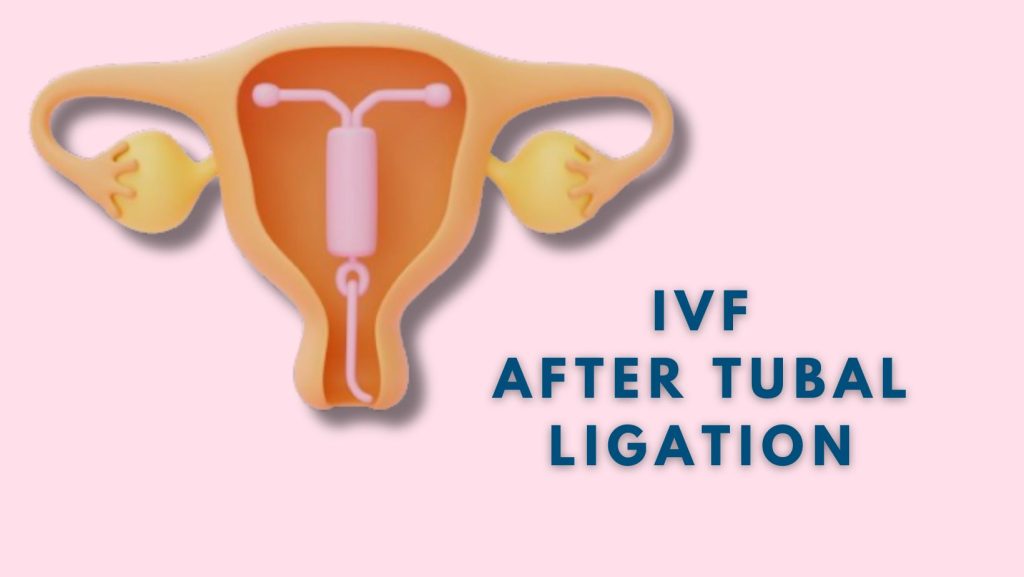IVF after Tubal Ligation – Pregnancy with Tubes Tied, Risks and Success Stories
Tubal ligation (also known as surgical sterilization) is one of the most popular methods of birth control. Despite its radical nature, many women resort to this procedure to permanently prevent pregnancy. What if your plans have changed, and you want to have a baby? IVF after tubal ligation is an effective and gentle way to get pregnant without surgery.

Today, we will discuss all the burning questions like what tubal ligation is, how to get pregnant with tubes tied, what the benefits of IVF are, and how the program works. Let’s start with the definition.
What Is a Tubal Ligation?
Tubal ligation is a permanent and difficult-to-reverse method of contraception. It is used in such cases:
- couples who do not plan to have children at all or have already completed their family;
- women carrying the BRCA1 and BRCA2 genes to prevent ovarian cancer;
- women for whom pregnancy may be dangerous.
It involves cutting, tying, and blocking to prevent the egg and sperm from meeting and, as a result, avoid fertilization and pregnancy. The ligation is performed using minimally invasive techniques, including hysteroscopy, mini-laparotomy, and laparoscopy. The procedure is sometimes performed during a cesarean section or within 2-3 days after childbirth.
The most crucial thing to remember is that tubal ligation makes a natural pregnancy almost impossible. Therefore, if you want to have a child in the future, you should look for alternative ways to conceive.
How to Get Pregnant with Tubes Tied, Cut and Burned?
Although natural conception is hardly possible after tubal ligation, there are two ways to get pregnant: reversal surgery and IVF. We will discuss each of them.
Reversal Surgery
Restoring the patency of the fallopian tubes after ligation is a complex and sensitive operation. It is performed through a laparotomy with an abdominal incision from 4 to 6 inches in length (which is much larger than for ligation!).
Reversal surgery is possible only in two cases:
- a small part of the fallopian tube was removed;
- they were blocked with rings or clips.
After the operation, a woman has to undergo a long recovery, including hospitalization and outpatient treatment for 2-3 weeks. Pregnancy itself may happen within a few years. The most significant disadvantage is that all the hardships do not guarantee a successful conception. So, even if the operation is successful, you will not be sure of fertility due to the possibility of scarring or the individual structure of organs.
IVF after Tubal Ligation
For those who want to have a better chance of fertilization without surgery, we recommend IVF. It is a much gentler procedure that does not require any manipulation with the fallopian tubes. Everything is straightforward: we transfer a fertilized egg directly into the uterus. Thus, you have every chance of carrying your healthy baby.
One of the significant advantages of IVF after tubal ligation is its speed. You don’t have to wait for rehabilitation and recovery: in 10 days, you can discover if the cycle was successful!
Of course, the program also does not guarantee fertilization. However, it protects you from complex invasions and gives results quickly.
IVF with Tubes Tied VS Reversal Surgery
IVF provides a better chance of conception using less traumatic methods. We have created a comparative table so that you can choose the most optimal option in your case.
| Aspect | Reversal Surgery | IVF |
| Procedure | Surgical reconnection | Fertilization outside the body |
| Protocol | Requires a skilled surgeon, specialized equipment, and times for recovery | It involves hormone injections, frequent monitoring, egg retrieval, and laboratory fertilization |
| Time to Conceive | 1-2 years | Conception possible within a few months |
| Risks and Complications | Risk of infection and ectopic pregnancy | No risks related to fallopian tubes |
| Success Rates | It may be unsuccessful in case of scarring, age, or individual characteristics. | Often, it is successful because it does not require the egg to pass through the tubes. |
How Does IVF Work with Tubes Tied?
IVF with tubal ligation is no different from the conventional protocol and has the same success rate. In short, the procedure works as follows. Eggs are retrieved from the ovaries and fertilized with sperm in a laboratory environment.

Doctors transfer the embryo directly into the uterus for further growth and development. All these processes take place in four stages:
1. Ovarian stimulation with hormone therapy
During a natural cycle, only one egg is produced. However, it may not be enough for a successful program. Therefore, based on tests and individual indicators, the doctor prescribes hormone therapy with injections to promote the development of several follicles and obtain 10-12 mature eggs.
2. Egg retrieval
At the final stage of maturation, the doctor injects a “trigger” hormone (most often hCG). After 35 hours after the injection, we collect the eggs by puncture. The procedure takes place under anesthesia or sedation and close supervision via ultrasound.
3. Fertilization
We initiate fertilization of the collected egg with sperm. It may be done more naturally, in a Petri dish, or with a hollow needle using the ICSI method. The embryos grow in an environment that mimics the fallopian tube.
4. Embryo transfer
When the embryo reaches the blastocyst stage, we may start the transfer. It is performed through a special catheter with ultrasound monitoring. The embryos are transferred through the cervix and end up directly in the uterus to further attach to the uterine wall and grow.
As you see, no stage involves the movement of cells through the fallopian tubes. Therefore, IVF after tubal ligation is an effective option for pregnancy.
Risks of IVF When Tubes Are Tied
IVF is a complex process that involves a thorough examination, well-chosen treatment, and constant monitoring. Of course, like any procedure, it has potential risks:
- ovarian hyperstimulation syndrome (OHSS);
- multiple pregnancies;
- miscarriage;
- stress.
We conduct all the necessary examinations and select therapy according to individual parameters, which significantly reduces the risk of developing any complications. Moreover, with regular monitoring, we guarantee the detection of problems at early stages.
IVF after Tubal Ligation Succes Rates
Successful IVF after tubal ligation is associated with the following factors:

- Egg quality. The quality of the eggs is of great importance in fertilization. So, you should check the ovarian reserve. The norm is the presence of 6-20 follicles during ultrasound in two ovaries.
- Sperm quality. The embryo comes from mom’s and dad’s cells. Therefore, the quality of sperm is as crucial as eggs. The condition of male cells is affected by age, concomitant diseases, unhealthy habits, etc. Thus, if the sperm is of poor quality, the chances of fertilization are reduced.
- Age. The likelihood of pregnancy decreases by the age of 38. Thus, older women should undergo a detailed consultation and check the condition of all organ systems to assess their success.
Below, you may view the results of a study on the success of pregnancies with sterilization among women in Western Australia.
| Aspect | Women with Previous Tubal Sterilization | Subfertile Controls |
| Cumulative Live-Delivery Rate (%) | 31% | 34% |
| Age Group | ||
| 20-34 years | 34% | |
| 35-39 years | 33% | |
| 40-44 years | 22% |
Cole Moss’s True Story of Pregnancy after Tubal Ligation
Cole Moss shares her experience of trying to get pregnant on her YouTube channel. She has undergone 4 rounds of IVF and does not give up hope for a long-awaited baby.
In this video, she talks about her experience with tubal obstruction:
I found out that both my tubes were fully clogged. The doctor told me I was never going to have children on my own. Then, I find out I have one tube that is open and one that is fully clogged. He told me that the reason why I wasn’t getting pregnant was probably all the fluid that was clogged in my right fallopian tube was probably killing the egg or the sperm before they had a chance to meet each other so if I got rid of that that hopefully I would be able to get pregnant on my own.
You can follow the link to see the full story and efforts.
Lindsay Hartsock’s Pregnancy after Tubal Ligation
Linsday was overwhelmed by her pregnancy after her sterilization. The woman shares her emotions on her YouTube channel and tells the story.
After our last baby, I had a tubal ligation, and my doctor really recommended it as a great form of birth control. But two years later, I hadn’t maintained a period. I thought maybe it was because we’ve had lots of graduations and graduation parties, and we’ve been working a lot. I felt that it was probably linked to stress, so I took a test to roll that out because I know that getting pregnant with a tubal ligation is extremely rare, but it can also be dangerous. So I took a test and noticed that there was a blue line right away, and it’s positive, like super positive! I could not believe it! I was shocked!
IVF after Tubal Ligation FAQ
IVF is a good way to get pregnant without reversal surgery. The procedure does not involve interaction with the fallopian tubes: the embryo is transferred directly into the uterus. Therefore, this method has a high success rate.
Yes. The absence of fallopian tubes is not an obstacle to IVF. Our Sunshine specialists successfully select therapy and perform all stages of IVF.
With sterilization, the IVF protocol is the same as the conventional one. Accordingly, the price is also the same. On average, it varies around $12,000.
IVF with sterilization has the same success as the program in women with subfertility. The most critical factors affecting fertilization are age, ovarian reserve, and sperm quality.

Final Words
As a result, tubal ligation is one of the most reliable and, at the same time, hard-to-reverse birth control methods. Fortunately, for those who have changed their reproductive plans, IVF is the optimal solution to having a baby without surgery. It does not require cells to pass through the tubes, so the condition of the fallopian tubes does not affect the success rate.
If you have any questions about IVF after tubal ligation and want to clarify the details, contact our specialists for a detailed consultation. Don’t hesitate to start your journey to complete your family right now!